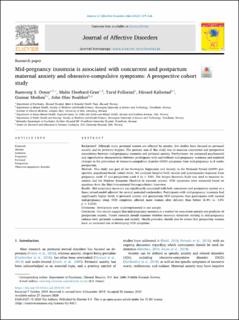| dc.contributor.author | Osnes, Rannveig Storaune | |
| dc.contributor.author | Eberhard-Gran, Malin | |
| dc.contributor.author | Follestad, Turid | |
| dc.contributor.author | Kallestad, Håvard | |
| dc.contributor.author | Morken, Gunnar | |
| dc.contributor.author | Roaldset, John Olav | |
| dc.date.accessioned | 2020-04-23T11:59:13Z | |
| dc.date.available | 2020-04-23T11:59:13Z | |
| dc.date.created | 2020-04-21T21:42:40Z | |
| dc.date.issued | 2020 | |
| dc.identifier.citation | Journal of Affective Disorders. 2020, 266 319-326. | en_US |
| dc.identifier.issn | 0165-0327 | |
| dc.identifier.uri | https://hdl.handle.net/11250/2652233 | |
| dc.description.abstract | Background
Although many perinatal women are affected by anxiety, few studies have focused on perinatal anxiety and its potential triggers. The primary aim of this study was to examine concurrent and prospective associations between mid-pregnancy insomnia and perinatal anxiety. Furthermore, we compared psychosocial and reproductive characteristics between participants with and without mid-pregnancy insomnia and explored changes in the prevalence of obsessive-compulsive disorder (OCD) symptoms from mid-pregnancy to 8 weeks postpartum.
Methods
This study was part of the Norwegian Depression and Anxiety in the Perinatal Period (DAPP) prospective, population-based, cohort study. We analyzed hospital birth records and questionnaire responses from pregnancy week 17 and postpartum week 8 (n = 530). The Bergen Insomnia Scale was used to measure insomnia and the Hopkins Symptom Checklist to measure anxiety. OCD symptoms were measured based on questions from the Mini-International Neuropsychiatric Interview.
Results
Mid-pregnancy insomnia was significantly associated with both concurrent and postpartum anxiety in a linear mixed model adjusted for several potential confounders. Participants with mid-pregnancy insomnia had significantly higher levels of perinatal anxiety and postpartum OCD symptoms than participants with normal mid-pregnancy sleep. OCD symptoms affected more women after delivery than before (6.4% vs. 3.8% p = 0.034).
Limitations
Immigrants were underrepresented in our sample.
Conclusion
Our results suggest that mid-pregnancy insomnia is a marker for concurrent anxiety and predictor of postpartum anxiety. Future research should examine whether insomnia treatment starting in mid-pregnancy reduces both perinatal insomnia and anxiety. Health providers should also be aware that postpartum women have an increased risk of developing OCD symptoms. | en_US |
| dc.language.iso | eng | en_US |
| dc.publisher | Elsevier | en_US |
| dc.rights | Navngivelse 4.0 Internasjonal | * |
| dc.rights.uri | http://creativecommons.org/licenses/by/4.0/deed.no | * |
| dc.title | Mid-pregnancy insomnia is associated with concurrent and postpartum maternal anxiety and obsessive-compulsive symptoms: A prospective cohort study | en_US |
| dc.type | Peer reviewed | en_US |
| dc.type | Journal article | en_US |
| dc.description.version | publishedVersion | en_US |
| dc.source.pagenumber | 319-326 | en_US |
| dc.source.volume | 266 | en_US |
| dc.source.journal | Journal of Affective Disorders | en_US |
| dc.identifier.doi | 10.1016/j.jad.2020.01.140 | |
| dc.identifier.cristin | 1807421 | |
| dc.description.localcode | This is an open access article distributed under the terms of the Creative Commons CC-BY license, which permits unrestricted use, distribution, and reproduction in any medium, provided the original work is properly cited. You are not required to obtain permission to reuse this article. | en_US |
| cristin.ispublished | true | |
| cristin.fulltext | original | |
| cristin.qualitycode | 1 | |

